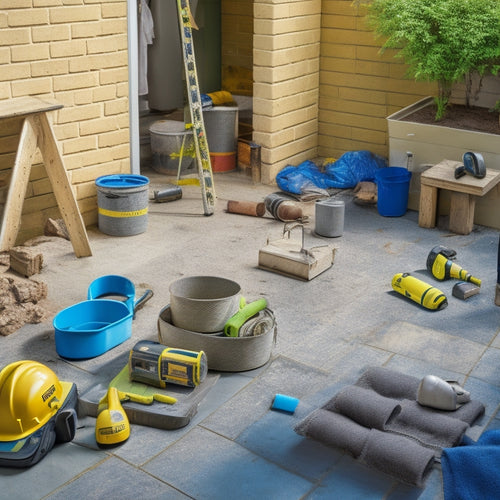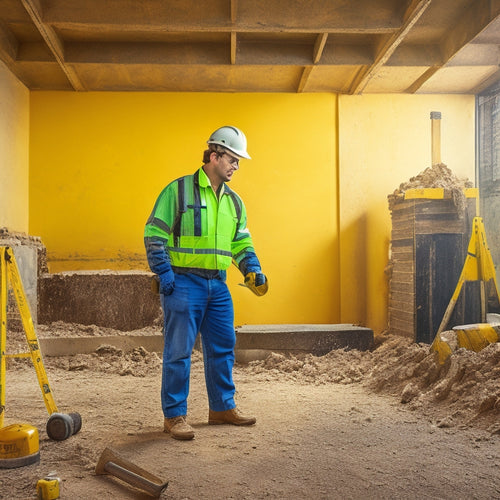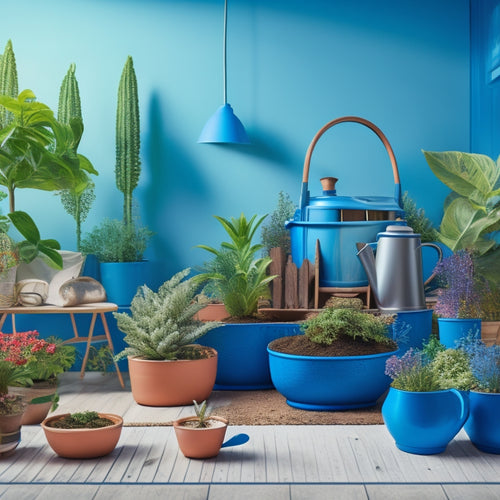
Mastering Texture Matching for Renovation Success
Share
As you prepare to transform a space, mastering texture matching is essential for renovation success. You'll need to evaluate the surface, identifying cracks, dents, and imperfections, and assess the substrate's condition. Next, prepare the damaged area, noting its size, shape, and imperfections, and clean and dry it for repair. Then, identify the original texture type by analyzing its characteristics and details, and choose materials that match its durability, color, and tone. By following these steps, you'll be well on your way to achieving a seamless renovation - and the secrets to perfecting your texture matching skills are just ahead.
Key Takeaways
• Conduct a thorough surface evaluation to identify cracks, dents, and imperfections, and document findings to inform repair strategy.
• Identify the original texture type by examining surrounding surfaces, using tools like magnifying glasses or texture scrapers, and documenting imperfections.
• Create a test patch to showcase texture, color, and pattern, and experiment with different materials and techniques to achieve optimal results.
• Apply the new texture using techniques like spraying, hand-troweling, or stamping, and reference notes to ensure a precise match during application.
• Blend the repair seam by feathering edges, matching sheen, and replicating original texture to achieve a seamless transition.
Prepare the Damaged Area
Before you begin the texture-matching process, carefully survey the damaged area to identify the extent of the damage and pinpoint any underlying issues that need to be addressed.
Take a close look at the surface, noting the size and shape of the damaged area, as well as any cracks, holes, or discoloration. This damage assessment will help you determine the best course of action for surface preparation.
As you assess the damage, think about what might be lurking beneath the surface. Are there any signs of water damage, structural issues, or previous repairs that didn't quite match the original texture?
Make a mental note of these potential underlying issues, as they'll impact your approach to surface preparation.
Proper surface preparation is key to a successful texture match. You'll need to clean and dry the area, removing any debris, dust, or old adhesive.
If necessary, you may need to sand or scrape the surface to create a smooth, even base for your repair.
Identify Original Texture Type
As you step back to examine the surrounding surface, take a closer look at the original texture, scrutinizing the intricate details that will help you pinpoint its type. This is where your detective skills come into play. Study the texture characteristics, such as its pattern, color, and sheen. Are there any imperfections or irregularities that can give away its type?
To aid your investigation, use specialized texture tools like a magnifying glass or a texture scraper to reveal hidden details. Take note of the texture's density, porosity, and flexibility. Does it have a rough, smooth, or glossy finish?
| Texture Type | Characteristics |
|---|---|
| Orange Peel | Small, rounded bumps; rough to the touch |
| Knockdown | Small, rounded bumps; slightly flattened |
| Swirl | Circular, spiral patterns; smooth to the touch |
| Popcorn | Small, rounded bumps; rough to the touch; often has a sparkly appearance |
Choose the Right Materials
With the original texture type identified, you can now select the ideal materials to recreate its unique characteristics, mirroring the intricacies you've uncovered. This is a vital step in achieving aesthetic harmony and ensuring your renovation looks seamless.
To make the right choice, consider the following key factors:
-
Material durability: Will the material withstand the wear and tear of daily use?
-
Color and tone: Does the material match the original color and tone, or can it be adjusted to achieve a perfect match?
-
Texture and pattern: Can the material replicate the unique texture and pattern of the original surface?
-
Moisture resistance: Is the material resistant to moisture, making it suitable for areas prone to humidity?
-
Budget and availability: Are the materials within your budget and easily accessible?
Create a Test Patch
Now that you've selected the ideal materials, it's time to craft a test patch that showcases their texture, color, and pattern, allowing you to fine-tune your match before committing to the full renovation. This essential step guarantees your final result will meet your high standards.
To create a convincing test patch, employ advanced test patch techniques that mimic the original texture and pattern. For instance, use a combination of troweling and stamping to replicate the unique texture of your original surface.
Next, focus on patch durability by applying a suitable adhesive and carefully blending the edges. This will help you gauge how well the patch will hold up over time.
As you work on your test patch, pay close attention to every detail, from the subtleties of color to the intricacies of pattern. Take your time, and don't be afraid to experiment and adjust as needed.
Match the Original Pattern
You're ready to scrutinize the original pattern, examining every nuance and detail to replicate it flawlessly in your test patch. This is where your observational skills come into play, as you explore the world of pattern analysis.
Take your time to study the original texture, noting the subtle variations in color, texture, and pattern.
Here are some key aspects to focus on:
-
Directional patterns: Identify the direction of the pattern, whether it's horizontal, vertical, or diagonal.
-
Repeating elements: Look for repeating shapes, motifs, or textures that make up the overall pattern.
-
Color variations: Note the subtle shifts in color tone, hue, and saturation that add depth to the pattern.
-
Texture depth: Examine the level of texture, from smooth to rough, and how it affects the overall look.
-
Pattern scale: Determine the scale of the pattern, whether it's large and bold or small and delicate.
Apply the New Texture
As you prepare to apply the new texture, envision the original pattern's intricate details coming to life on your canvas, infused with the nuances you've carefully observed and analyzed. Now, it's time to bring your vision to life using expert texture application techniques.
Texture Application Methods Comparison
| Method | Advantages | Challenges |
|---|---|---|
| Spray Texture | Fast, even coverage | Requires practice for uniform pattern |
| Hand-Troweled | High level of control, detailed work possible | Time-consuming, labor-intensive |
| Stamped Texture | Creates unique, organic patterns | May require specialized tools |
When using spray texture methods, remember to adjust the nozzle to achieve the desired pattern size and density. For hand-troweled textures, work in small sections to maintain consistency. Whichever method you choose, take your time to guarantee a seamless blend with the surrounding area. As you apply the new texture, remember to reference your notes and observations to guarantee a precise match. With patience and attention to detail, you'll achieve a flawless, professional-looking finish that will impress even the most discerning eye.
Blend the Repair Seam
With the new texture expertly applied, your focus shifts to seamlessly integrating the repair area with the surrounding surface, creating a harmonious visual flow that conceals the seam. This vital step requires finesse and attention to detail to guarantee a flawless blend.
To achieve a seamless repair, you'll need to employ the right texture tools and repair techniques. Here are some essential tips to keep in mind:
-
Feather the edges: Gradually blend the new texture into the surrounding surface, feathering the edges to create a smooth changeover.
-
Match the sheen: Verify the finish of the repair area matches the surrounding surface, whether it's matte, satin, or glossy.
-
Use the right tools: Select texture tools that mimic the original texture, such as a putty knife or texture scraper.
-
Work in small sections: Divide the repair area into smaller sections, blending each one at a time to maintain control.
-
Step back and evaluate: Periodically step back to assess the blend, making adjustments as needed to achieve a seamless integration.
Inspect and Refine
As you step back to examine your work, you're not just looking for obvious flaws - you're scrutinizing every detail, from the subtle play of light on the surface to the intricate patterns that make up the texture.
You're on the hunt for any discrepancies that might disrupt the seamless blend you're aiming for.
Assess Current Conditions
You stand in front of your canvas, scrutinizing the initial texture you've created, searching for any inconsistencies or areas that cry out for refinement. As you assess the current conditions of your renovation project, you're not just looking at the surface level – you're digging deeper to uncover any potential issues that could impact your final result.
During this stage, it's crucial to conduct a thorough surface evaluation and damage assessment. This involves:
-
Inspecting the surface for cracks, dents, or other imperfections
-
Checking for signs of water damage, mold, or mildew
-
Evaluating the condition of the substrate, including its porosity and absorbency
-
Identifying areas where the original material may be compromised or weakened
-
Documenting your findings to inform your repair and restoration strategy
Identify Discrepancies Early
Every inch of your canvas warrants scrutiny, so scrutinize you must, magnifying glass in hand, to pinpoint even the slightest discrepancies in texture, tone, or pattern. This is where discrepancy detection becomes your superpower. As you inspect each area, you're not just looking at the surface; you're analyzing the intricate dance of texture, tone, and pattern. Your trained eye is on the hunt for any deviation from the norm, no matter how slight.
In this texture assessment, every detail matters. A single misaligned brick, a faint scratch on the wall, or a subtle shift in color can throw off the entire aesthetic. You're the master of your renovation domain, and it's your job to identify these discrepancies early.
Don't let them sneak up on you later, causing costly delays or compromising the integrity of your design. By being meticulous now, you'll save yourself headaches down the line. So, take your time, and inspect every inch of your canvas. Your renovation success depends on it.
Refine Material Selection
With a keen eye for detail, scrutinize your material selection, confirming that each element harmoniously blends with the others, much like the intricate pieces of a puzzle coming together to form a stunning visual narrative.
As you refine your material selection, you're not just choosing products – you're crafting an immersive experience that will transport your clients to their dream space.
Here are some essential considerations to keep in mind:
-
Eco-friendly materials: Prioritize sustainable options that not only benefit the environment but also elevate the aesthetic appeal of your design.
-
Advanced texture tools: Leverage cutting-edge technology to create intricate textures, patterns, and finishes that add depth and visual interest to your design.
-
Material authenticity: Confirm that each material selection is faithful to its original inspiration, whether it's a rustic wood grain or a sleek metal finish.
-
Color cohesion: Balance your color palette to create a sense of harmony, using advanced color-matching tools to guarantee a perfect blend.
-
Sensory engagement: Consider how each material will engage the senses, from the tactile experience of natural stone to the soft glow of ambient lighting.
Frequently Asked Questions
Can I Use a Texture Matcher Tool for Stucco and EIFS Systems?
You're wondering if a texture matcher tool is the right fit for stucco and EIFS systems? The answer is yes!
With a texture matcher, you'll access benefits like consistency and efficiency in your texture application techniques.
Imagine being able to precisely replicate the unique texture of your stucco or EIFS surface, ensuring a seamless blend with the surrounding area.
This tool gives you the control you need to achieve professional-looking results with ease.
How Do I Handle Repairs in Areas With High Humidity and Moisture?
When tackling repairs in areas with high humidity and moisture, you'll need to get strategic.
First, choose humidity-resistant materials that can withstand the damp environment.
Then, employ moisture-proof techniques like applying a waterproof membrane or sealant to prevent future damage.
Visualize the repair area as a fortress, and you're the master builder, fortifying it against the elements.
Are There Specific Safety Precautions for Working With Asbestos-Containing Textures?
When tackling texture removal, you'll want to prioritize asbestos safety above all.
Wear protective gear, including a respirator, gloves, and a disposable suit, to prevent exposure.
Seal off the work area with plastic sheets to contain the mess.
Use a HEPA-filter vacuum to capture tiny fibers, and mist the texture with water to reduce dust.
Can I Reuse Original Materials for the Repair or Must I Buy New Ones?
Can you really recreate the past with the same materials, or is it a fool's errand? When deciding whether to reuse original materials or buy new ones, you're faced with an essential question.
Consider material compatibility - will the old textures seamlessly blend with new ones? Restoration techniques play a significant role here.
If you can't find an exact match, it's better to opt for new materials that guarantee a cohesive look.
How Long Does a Typical Texture Matching Project Take to Complete?
You're probably wondering how long it'll take to get your texture matching project off the ground.
The truth is, it depends on several factors that affect your project timeline. The complexity of the texture, size of the area, and your chosen technique all play a role.
With advanced texture matching techniques, you can expect a project to take anywhere from a few days to several weeks.
Be prepared to adapt to changes and unexpected challenges that may arise.
Conclusion
You've mastered the art of texture matching, and now your renovation is on track for success!
According to the National Association of Home Builders, 75% of homeowners undertake renovation projects to increase their home's value.
By following these steps, you'll be among the triumphant ones, boasting a seamless repair that blends in perfectly.
Take a step back, admire your handiwork, and revel in the satisfaction of a job well done.
Your attention to detail has paid off, and your home is now a reflection of your skills.
Related Posts
-

7 Patio Safety Tips for DIY Renovation Projects
As you begin your DIY patio renovation project, prioritize safety by evaluating the worksite for tripping hazards and...
-

5 Vital Safety Tips for DIY Renovation Success
When tackling a DIY renovation, you'll need to prioritize safety above all else. Start by protecting yourself from fl...
-

3 Best Planter Shopping Timeline Tips for Renovators
When incorporating planters into your renovation project, you'll want to plan carefully to avoid delays and guarantee...


